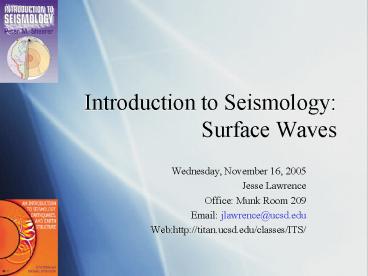Introduction to Seismology: Surface Waves - PowerPoint PPT Presentation
1 / 23
Title:
Introduction to Seismology: Surface Waves
Description:
Geometry for Love & Rayleigh Wave Motion. The Earth Rings Like a Bell: ... Time between bounces is given by pX(p), where p is the ray parameter. ... – PowerPoint PPT presentation
Number of Views:460
Avg rating:3.0/5.0
Title: Introduction to Seismology: Surface Waves
1
Introduction to SeismologySurface Waves
- Wednesday, November 16, 2005
- Jesse Lawrence
- Office Munk Room 209
- Email jlawrence_at_ucsd.edu
- Webhttp//titan.ucsd.edu/classes/ITS/
2
Surface Waves
3
Geometry for Love Rayleigh Wave Motion
4
The Earth Rings Like a Bell
5
Rayleigh Wave Displacement as a Function of Depth
6
Horizontal Vertical Rayleigh Wave Motions
7
Love Waves
- Constructive interference of SH wave multiples.
- Destructive interference occurs at all but a few
specific times at a given location - Time between bounces is given by pX(p), where p
is the ray parameter. - The phase velocity is given by
- c 1/p k/?
- Phase velocity is dependent upon frequency, which
causes dispersion.
X(t)
8
Love Waves Continued
- Constructive interference of SH wave multiples.
- When phase velocity varies by frequency
(dispersion) interference occurs, making energy
travel at a different velocity called the group
velocity - With some math
X(t)
9
Love Waves Continued
T
Group Velocity
Phase Velocity
- Phase Velocity
- c k/?
- Group Velocity
SSS
SS
S
X
10
Love Wave Geometry
- Love waves occur because incoming SH waves are
trapped within a Layer - In other words the layer acts as a waveguide.
- interference between incoming and layer-reflected
waves. - This only happens at just the right angle of
incidence - This angle is defined by the modes of Earths
geometry.
11
Love Wave Geometry
12
Love Wave Dispersion
- Dispersion occurs because longer-period waves
sample more of the halfspace, and travel at
faster velocities.
13
Displacement of Love Waves
- A Love Wave oscillates as cos(kxr?1z) in a layer,
but decays exponentially as exp(-kxr?2z) in the
halfspace below. - The vertical sensitivities of the modes are the
eigenfunctions.
14
Modes
15
Phase v. Group Velocity
- Sum two harmonic waves with slightly different
frequency and wavenumbers - u(x,t) cos(?1t-k1x) cos(?2t-k2x)
16
Phase v. Group Velocity
- Phase Velocity
- c(?) ?/k(?)
- ? 1/period, k 1/wavelength
- c(?) is distance/time
- Group Velocity
- U(?) d?/dk
- U(?) distance/time
17
Fundamental Mode Love Wave Group Phase
Velocities
18
Love Wave Group Dispersion
19
Love Wave Group Dispersion
- Filter a single wave at a bunch of different
frequencies/periods. - Longer periods arrive earlier than shorter ones.
20
Walvis Ridge Rayleigh wave group velocity
- Group velocity is lower on the ridge than off the
ridge because of a shallow low velocity layer at
85 km depth.
21
East Pacific Rise Phase Velocities
22
Phase Velocity Oceanic Plate Age
Dispersion curves as function of age
Inverted structure
- Higher velocities for older oceanic plates
- Thick, cold lithosphere leads to higher
velocities
23
Global Surface Wave Maps































